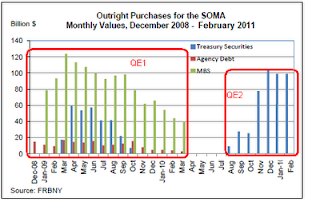by: Steven Hansen April 10, 2011
If we take the noise coming out of the Federal Reserve as gospel, QE2 will end before the end of June 2011. In simple words, QE (aka quantitative easing) is in effect the same as government buying its own debt.
As we speak, the Federal Reserve holds $1.3 trillion of Treasuries (15% of the total $9 trillion outstanding) on its balance sheet. As a matter of fact, the Fed is not the government. As a matter of effect, the Fed has dual agency as the provider of currency (a government agent) and as a coordinating agent for the private sector (banking).
One caveat in looking at the above graph’s QE2 purchases (click to enlarge), it does not credit the expiring Treasury, Agency and MBS debt instruments – but the net effect of QE2 is to increase the Fed’s balance sheet by $600 billion. QE2 roughly removed $200 billion per quarter ($800 billion annualized) of “investment” from the private sector.
It could be argued QE2 provided capital to the private sector. The government increased debt by $600 billion. This debt was sold to the banks. The Fed then printed currency (Federal Reserve notes and credits) and bought the debt from the banks. The net affect: government debt increased by $600 billion and private currency in the banks increased by the same amount. This allowed this $200 billion per quarter to be “invested” elsewhere.
What happens when QE2 ends?
Fed Chairman Bernanke said QE2 has “contributed to a stronger stock market just as they did in March 2009 when we did the first iteration of this program.” Is it a stretch to believe it created a bubble which will correct once QE2 is terminated?
Will the USA economy contract or become less good?
The major reason for implementing QE2 were indications that the economy was contracting following termination of QE1. The economy is currently moderately stronger – and is on less life support relative to one year ago. Logically, removing a leg of economic support at any time should be economically negative. The government will stop increasing debt which had the function of pumping currency into the banking system.
Little of this $600 billion of QE2 made it directly into GDP. GDP measures roughly 1/3 of all money flows in the USA.
QE2 is more like a true stimulus with multiplier effects directed towards investing and money flows. Many have argued much of the effects of QE2 surfaced in emerging economies which were capable of soaking up this amount of stimulus, although with increasing inflation.
Would ending QE2 reverse this and begin repatriating dollars invested in emerging economies?
Depends on non-QE2 factors.
• rising central bank interest rates in China and Europe, or capital inflows to buy Treasuries affect the relative value of the dollar;
• will the Fed continue to maintain its balance sheet levels, or allow them to decay;
• the strength of the USA economy versus the global economy going forward – this effects the flow of investing money which seeks the highest return.
The bottom line is that there is no certainty except that the Fed will not sit by and watch the economy crash.

No comments:
Post a Comment